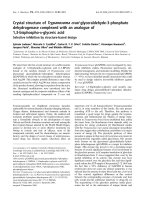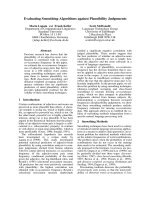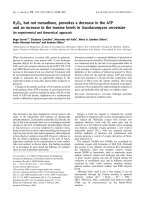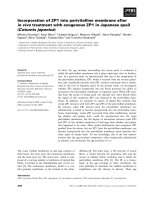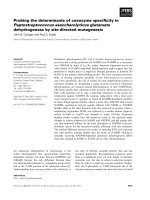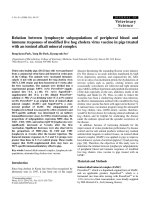Báo cáo khoa học: " Host Immune Responses Against Hog Cholera Virus in Pigs Treated with an Ionized Alkali Mineral Complex" pot
Bạn đang xem bản rút gọn của tài liệu. Xem và tải ngay bản đầy đủ của tài liệu tại đây (66.03 KB, 5 trang )
J O U R N A L O F
Veterinary
Science
J. Vet. Sci. (2002), 3(4), 315-319
Abstract
9)
To determine the immune responses in pigs to hog
cholera virus after tre atment w ith an ionized alkali
mineral complex (IAMC), 40 healthy pigs (28-32 days
old) from a commercial swine farm w ere purchased
and housed into 4 groups (n=10 each). All pigs w ere
vaccinated intramuscularly (1 ml) with an attenuated
live hog cholera virus (HCV, LOM strain) at 28-32
days old and challenged w ith a virulent hog cholera
virus at 8 w eeks after vaccination. Each group w as
treated w ith Pow erFeelTMsprayed diet as 0.05% (w /w )
in a final concentration (T-1, n=10), a diet mixed with
SuperFeedTMas 3%(w /w ) in a final concentration (T-2,
n=10), or a diluted Pow erFeelTMsolution (1:500, v/v) as
drinking w ate r (T-3, n=10), respectively. A group
(n=10) served as a non-treate d control. Proportions of
expressing CD2+ and CD8+ cells increased significantly
(p<0.05) at 8-w eek post-application. Mean antibody
titers of each group against HCV gradually increased
to higher levels after vaccination and w ith challenge
of the virulent virus. In conclusion, the IAMC-treated
diets can be helpful for the improvement of growth in
pigs with proper vaccination program, w hile the
IAMC-treated diets have no effects on the clinical
protection against hog cholera.
Key w ords
: Ionized alkali mineral complex, Hog cholera
virus, Porcine immune cells.
Introduction
Hog cholera, so called classical swine fever, is an acute
infection manifested by high fever, depression, anorexia and
conjunctivitis [3]. After that, nervous system dysfunctions, a
*
Corresponding author: Bong-Kyun Park
College of Veterinary Medicine, Seoul National University, Suwon
441-744, Korea
Tel : +82-31-290-2715, Fax : +82-31-293-2392
E-mail :
diffuse hyperemia and purplish discoloration of the light
skin are exhibited [13]. In Korea the disease has been one
of the major diseases that are threatening the expanding
Korean swine industry since 1947 [7]. Thus, the national
eradication program of a virulent hog cholera virus infection
in the industry is of major veterinary importance. Protective
immunity of an attenuated live hog cholera virus (LOM
strain) vaccine has been well approved in Korea through the
establishment of solid serum-neutralizing antibody [6].
Under the sporadic occurrence of the disease annually,
therefore, national mass-vaccination program by the
government has suggested the first vaccination at 40 days
old and the second vaccination at 60 days old, with annually
booster injection for adults. Since December, 2001 the
Korean government has ceased vaccination policy against
hog cholera.
As a nonspecific immunostimulator, ionized alkali mineral
complex (IAMC) which consists of Si, Ag, Na and K ions,
has been applied for the improvement of swine growth [Y.H.
Park et al. 1998. Proceed 15th Int. Pig Vet. Soc., Birmingham,
England, p22]. Immunostimulatory effects on pigs were
demonstrated through proliferation and activation of porcine
immune cells [9, 14]. However, the effects to host animals
and practical mechanisms are of controversy.
Thus, the objective of this study was to determine the
host immune responses to a virulent hog cholera virus in
pigs vaccinated with a dose of an attenuated live hog
cholera virus vaccine with an IAMC treatment.
Materials and Methods
Ionized alkali mineral complex (IAMC)
PowerFeelTM and SuperFeedTM were kindly supplied by
NEL Biotech Co., Ltd. (Ansung, Korea).
Animals and treatments
Forty healthy pigs (28-32 days old) from a commercial
swine farm were purchased and housed into 4 groups at
swine pens of the College Experiment Station. Each group
(n=10) was treated with a diet described previously [9]. In
brief, pigs of T-1 were treated by a basic diet sprayed with
Host Immune Responses Against Hog Cholera Virus in Pigs Treated with an Ionized
Alkali Mineral Complex
Bong-Kyun Park, Kwang-Soo Lyoo, Yong-Ho Park, Jong-Ho Koh* and KyungSuk Seo*
College of Veterinary Medicine and School of Agricultural Biotechnology, Seoul National University, 441-744 Suwon, Korea
*NEL Biotech Co., Ltd.
Received April 2, 2002 / Accepted November 23, 2002
316 Bong-Kyun Park, Kwang-Soo Lyoo, Yong-Ho Park, Jong-Ho Koh and Kyung-Suk Seo
PowerFeelTMsolution as 0.05% (w/w) in a final concentration
and those of T-2 were treated with a basic diet mixed with
SuperFeedTMas 3% (w/w) in a final concentration. Pigs of
T-3 were treated with a diluted PowerFeelTM solution
(1:500, v/v) as drinking water and control pigs were treated
with a basic diet and tap water.
Isolation of leukocytes and monoclonal antibodies
Peripheral bloods were collected from pigs at pre-
application, 5-, 8- and 12-weeks post-application (PA) of the
IAMC, respectively and leukocytes were separated by a
method described in a previous report [9]. Six monoclonal
antibodies reactive to porcine leukocyte differentiation
antigens, H42A, MSA4, PT90A, PT81B, Pig45A and PT79A
[9] were used for a flow cytometry (FACSCalbur, Becton
Dickinson Immunocytometry Systems, San Jose, CA,
U.S.A.), and acquired data were then analyzed with a Cell
Quest program (Becton Dickinson, version 3.1f). The
percentages of lymphocytes with epitopes to the various
antibodies were calculated.
Hog cholera virus and clinical observations
All pigs were vaccinated intramuscularly (1 ml) with an
attenuated live hog cholera virus (LOM strain) at 28-32
days old and challenged intranasally with a virulent hog
cholera virus (2 ml, 104.0TCID50/ml) at 8-weeks post-vaccination.
Clinical observations were performed daily for 4 weeks after
challenge.
Serology
Sera were collected at the same intervals from peripheral
bloods and hog cholera virus specific antibodies were
detected by an indirect immunofluorescent assay (IFA) [16].
For the IFA test, PK-15 cell monolayers infected with hog
cholera virus (LOM strain) were prepared in 96-well test
plates. The 0.2 ml of the cell suspension (1
×
105cell/ml) was
transferred to each well of 96-well plates and incubated for
24 hours at 37
℃
. The monolayers were washed 3 times with
phosphate buffered saline (PBS, pH7.4) and 0.2 ml of the
virus (103.0 TCID50/ml) was transferred to each well. This
was incubated at 37
℃
for 72 hours and then the medium
in the plates was replaced by a cold mixture of 5% acetone
in absolute ethanol (0.1 ml/well). The plates were stored at
-20
℃
until use. Negative and positive control sera were
included in each test. IgG IFA test using commercial
antiswine IgG fluorescein isothiocyanate conjugate (Kirkegaard
& Perry Laboratories, Gaithersburg, MD, USA) were
performed as previously described [15].
Statistical analysis
The Student’s t test was used to compare the mean
values obtained from three groups. One way analysis was
performed with the mean values from three treated groups
against that of control. Data were expressed as mean
±
SD.
Results
Proportional comparison of porcine leukocyte subpopulations
in pigs treated with non-specific immunomodulators was
summarized in Table 1. As shown in the table, proportions
of some subpopulation in pigs were variable before IAMC
application. Proportion of expressing MHC-class II decreased
at 5-weeks post-application in T-1 group and at 8-weeks
post-application in T-2 pigs, while that increased at 4-weeks
after challenge in all three treated groups, when compared
to non-treated control group. However, there was no significant
difference between those of all three treated groups and that
of control. In the proportions of T lymphocyte (CD2+) against
that of control group increased significantly at 8 weeks
post-application in T-1 and T-2 groups (p<0.05). Proportion
of expressing PoCD4+ increased only in T-3 group against
control at 8-weeks post-application. In proportions of expressing
PoCD8+, T-1, T-2 and T-3 had significantly higher mean
values at 8-weeks post-application (p<0.05), while all treated
groups had lower values after challenge when compared to
control. The proportion of surface IgM+B lymphocytes against
that of control decreased with significant change for T-1 at
5-weeks post-application. In the proportions of N cells
against that of control, there were no significant changes.
Antibody titers against hog cholera virus (HCV) were
measured through the detection of HCV-specific antibodies
(Tables 2). Before vaccination pigs were variable in the level
of maternal antibody titers (<1:4~1:256). Mean antibody
titers of each group against HCV increased gradually after
the vaccination of the attenuated live hog cholera vaccine
(LOM strain) virus to higher levels with challenge of the
virulent hog cholera virus. The distribution of titers was
1:16~1:256 at 5-weeks postvaccination and 1:16~1:1,024 at
8-weeks postvaccination. The humoral immune responses
were increased dramatically by a virulent hog cholera virus
(the titers 1:256~1:4,096). Clinical observations after challenge
infection revealed high fever, depression, anorexia, conjunctivitis,
diarrhea and purplish discoloration in a few pigs of all
groups.
Discussion
Several studies have indicated that cell-mediated immunity
is not a critical factor, but humoral immunity plays a major
role in protection against hog cholera virus infection [1, 12].
The marked correlation between the titer of neutralizing
antibodies and the protective effect after immunization with
attenuated live hog cholera virus vaccine was approved.
Therefore, humoral immune mechanisms are important host
defense reactions in hog cholera virus infection [6]. Before
vaccination pigs were variable in the level of antibody titers
against hog cholera virus (<1:4~1:256). This kind of
antibody might influence the vaccine efficacy, so mean
antibody titers of each group against HCV increased
gradually after the vaccination of the attenuated live hog
Table 1.
Proportional comparison of porcine leukocyte subpopulations in pigs treated with ionized alkali mineral complex
Weeks post-application
Group 0 5 8 12
<MHC class
Ⅱ
cells>
T-1
T-2
T-3
Con
13.73
±
1.33
*
12.20
±
3.01
15.50
±
2.29
16.09
±
7.79
15.56
±
6.25
17.86
±
6.61
17.05
±
5.90
19.88
±
4.82
23.80
±
5.95
17.46
±
4.18
26.51
±
3.55
24.78
±
13.03
16.03
±
4.72
17.54
±
4.55
18.37
±
6.31
14.65
±
4.17
<CD2+ cells>
T-1
T-2
T-3
Con
77.28
±
4.98
77.72
±
8.01
83.10
±
0.00
77.95
±
6.73
67.03
±
7.18
74.20
±
13.11
71.08
±
9.84
70.35
±
16.66
78.48
±
5.24a
81.61
±
6.74a
74.91
±
11.46
71.96
±
5.88
59.43
±
9.30
59.70
±
16.18
62.60
±
5.92
61.30
±
17.11
<CD4+ cells>
T-1
T-2
T-3
Con
25.47
±
4.05
26.12
±
8.80
37.30
±
7.35
29.80
±
11.90
23.84
±
6.25
27.80
±
9.05
22.52
±
6.86
25.05
±
9.51
29.44
±
4.97
28.60
±
10.89
34.47
±
5.45
29.68
±
5.55
24.20
±
5.54
27.86
±
12.47
27.87
±
4.45
26.05
±
1.48
<CD8+ cells>
T-1
T-2
T-3
Con
38.18
±
7.95
40.10
±
10.44
40.05
±
10.25
39.30
±
13.03
46.81
±
11.77
49.53
±
15.58
43.32
±
12.37
44.80
±
13.27
45.19
±
13.52a
55.41
±
18.66a
41.99
±
12.02a
31.06
±
7.46
34.85
±
5.30
34.12
±
10.79
37.07
±
15.77
40.85
±
1.10
<B cells>
T-1
T-2
T-3
Con
9.85
±
3.72
10.66
±
3.40
12.05
±
0.49
12.00
±
5.65
3.73
±
1.62a
7.85
±
3.32
12.18
±
6.30
9.33
±
4.99
14.56
±
3.41
15.73
±
6.20
25.61
±
6.49
22.98
±
9.96
11.20
±
1.85
12.40
±
5.81
16.14
±
11.67
19.95
±
2.86
<N cells>
T-1
T-2
T-3
Con
18.25
±
4.61
18.78
±
6.42
18.70
±
3.68
18.03
±
5.21
17.87
±
4.56
20.13
±
6.30
24.25
±
6.69
23.05
±
7.77
17.17
±
3.23
19.04
±
3.35
28.28
±
6.70
27.95
±
10.63
23.00
±
2.05
23.43
±
7.49
21.40
±
8.84
18.45
±
2.19
All pigs were vaccinated with 1 ml of attenuated live hog cholera virus (LOM strain) vaccine intramuscularly at 28-32 days
old and challenged with a virulent hog cholera virus (2 ml, 104TCID50/ml).
T-1 : pigs treated with a basic diet sprayed with PowerFeelTM solution to be 0.05% (w/w) in a final concentration.
T-2 : pigs treated with a basic diet mixed with SuperFeedTM to be 3% (w/w) in a final concentration.
T-3 : pigs treated with a diluted PowerFeelTM solution (1:500, v/v) as drinking water.
Con; pigs supplied with a basic diet and tap water.
* : mean
±
SD
a : significant difference against that of control (p<0.05).
Host Immune Responses Against Hog Cholera Virus in Pigs Treated with an Ionized Alkali Mineral Complex 317
318 Bong-Kyun Park, Kwang-Soo Lyoo, Yong-Ho Park, Jong-Ho Koh and Kyung-Suk Seo
cholera virus (LOM strain). Therefore, under the sporadic
occurrence of the disease, national mass-vaccination program
ought to recommend two injections at 3-weeks interval.
A previous report suggested that the infection of lym-
phocytes contributes to the depletion in their numbers after
infection and leads to defective antibody production during
the infection of virulent classical swine fever virus [8].
However, the humoral immune responses increased dramatically
by challenge of a virulent hog cholera virus (the titers
1:256~1:4,096). It seemed that the challenge hog cholera
virus originated from chronic case of the disease might have
the booster effect. By the way, the weak point of this study
was that the pathogenicity of a virulent challenge virus was
not confirmed in pigs after isolation from the chronic case
of the disease. Again previous reports mentioned that a
modified live hog cholera virus (LOM strain) vaccine has the
pathogenicity like other virulent strains of hog cholera
virus, while the virulence of the virus is much less than
them [5, 11]. Further study remains to determine the viral
characteristics among field viruses.
The host immune system could be elucidated using a
panel of monoclonal antibodies specific to leukocyte differen-
tiation molecules of animal species [2]. Along with severe
decrease of leukocyte and lymphocyte counts, each number
of MHC class II, CD1 CD2, CD4, CD8 antigen positive cells
and CD4+CD8+ double positive cells and sIgM+ B cells
decreased abruptly two days after inoculating virulent ALD
strain of HCV. However, each count of subpopulations were
not recovered during the time of experiment until death of
pigs [5, 10]. In addition, in pigs vaccinated with attenuated
live hog cholera virus, absolute numbers of leukocyte,
lymphocyte and lymphocyte subpopulations with the exception
of the null cells decreased transiently from 2 to 8 days after
inoculation [4]. As shown in the Table 1, proportions of
some subpopulation in pigs were variable before IAMC
application, while the variability became constant after the
treatment. An IAMC-treated pigs showed significant reduction
of the lymphocyte subpopulations compared with those of
control, suggesting that the virus replication and persistence
in the leukocytes after hog cholera virus infection might be
altered, resulting in the most important features in the
pathogenesis of hog cholera in pigs. Pathogenic mimic of hog
cholera virus in pigs treated with the IAMC should be
further discussed on the viral pathogenicity with relation to
the mechanism of antibody production.
Those of expressing MHC-class II showed significant
increase at 4-weeks after challenge in T-2 pigs. However, in
the proportions of T lymphocyte (CD2+) against those of
control group significant increases were observed at 8-weeks
post-application in T-1 and T-2 pigs, also at 4-weeks after
challenge in T-1 and T-3 pigs. Those expressing PoCD4+
showed significant increase only for that of T-3 against that
of control at 8-weeks post-application (p<0.05). In addition,
in those expressing PoCD8+all three groups showed significantly
higher mean values at 8-weeks post-application against
those of control, whereas the change against T-3 group was
significant for that of T-2 at 8-weeks post- application and
for that of T-3 at 4-weeks after challenge (p<0.05). This
result suggested that the cell-mediated immunity also plays
a important role in hog cholera virus infection. Interestingly,
pigs treated with IAMC have achieved a significant
improvement compared to control pigs, but there was no
difference on the clinical protection against a virulent strain
of hog cholera virus among the groups (data not shown).
Table 2.
Indirect fluorescent antibody titers against hog cholera virus in pigs
Weeks post-application
Group No of pig 0 5 8 12
T-1
T-2
T-3
Control
10
10
10
10
<4 - 16
(0.50)
*
< - 16
(0.60)
<4 - 256
(1.33)
<4 - 64
(1.11)
16 - 256
(2.20)
16 -256
(2.63)
16 -256
(3.00)
16
(2.00)
16 -64
(2.50)
16 -1,024
(3.14)
64 -256
(3.44)
16 - 256
(3.00)
256 - 4,096
(5.40)
1,024 - 4,096
(5.57)
64 - 4,096
(4.88)
256 - 4,096
(5.38)
All pigs were vaccinated with 1 ml of modified live hog cholera virus (LOM strain) vaccine intramuscularly at 28-32 days
old and challenged with a virulent hog cholera virus (2 ml, 104TCID50/ml) at 8-weeks post-application.
T-1 : pigs treated with a basic diet sprayed with PowerFeelTM solution as 0.05% (w/w) in a final concentration.
T-2 : pigs treated with a basic diet mixed with SuperFeedTM as 3% (w/w) in a final concentration.
T-3 : pigs treated with a diluted PowerFeelTM solution (1:500, v/v) as drinking water.
Con : pigs supplied with a basic diet and tap water.
* mean IFA titers (Log4x).
Host Immune Responses Against Hog Cholera Virus in Pigs Treated with an Ionized Alkali Mineral Complex 319
Acknowledgement
This project was financially supported by NEL Biotech
Co., Ltd. and Research Institute for Veterinary Sciences,
College of Veterinary Medicine, Seoul National University.
Also, the authors thank to Mrs. Sook Shin for technical
assistance.
References
1.
Corthier, G.
Cellular and humoral immune response
in pigs given vaccine and chronic hog cholera viruses.
Am. J. Vet. Res. 1978,
39
, 1841-1844.
2.
Davis, W.C., Hamilton, M.J. and P ark Y.H.
Ruminant leukocyte differentiation molecules In: Barta.
MHC, differentiation antigen, and cytokines in animal
and birds. Monographs in Animal Immunol., VA:BAR-1
AB Inc., Blacksburg, 1990, pp47-70.
3.
Fenner, F.J., Gibbs, E.P.J., Murphy, F.A., Rott, R.,
Studdert, M.J. and White, D.O.
Veterinary virology.
2nd ed. Academic Press, Inc., San Diego, 1993, pp441-454.
4.
Hwang, E.K., Kim, J.H., Kwoen, C.H., Kim, B.H.,
Yoon, Y.D. and Yang, C.K.
Peripheral blood lymphocyte
subpopulations of pigs inoculated with modified live
virus hog cholera vaccine(LOM strain). RDA J. Veterinary
Sci. 1997,
39(2)
, 51-58.
5.
Hwang, E.K., Kim, J.H., Yoon, S.S., Kim, B.H. and
Yoon, Y.D.
Lymphocyte subpopulations of peripheral
blood in pigs experimentally inoculated with hog
cholera virus. RDA J . Agri. Sci. 1994,
36(1)
, 576-586.
6.
Kang, B.J., Kwon, H.J., Lee, H.S. and Park, D.K.
Studies on the application of LOM hog cholera vaccine
to domestic swine in Korea. Res. Rept. RDA(V) 1967,
10(5)
, 85-93.
7.
Kim, Y.H.
Hog cholera. History of preventive medicine
of domestic animals. Vol II, Korean Veterinary Medical
Association, Seoul, 1967, pp33-45.
8.
Lee, W.C., Wang, C.S. and Chien, M.S.
Virus antigen
expression and alterations in peripheral blood mononuclear
cell subpopulations after classical swine fever virus
infection. Vet. Microbiol. 1999,
67
, 17-29.
9.
Park, B.K., Park, Y.H. and Seo, K.S.
Lymphocyte
subpopulations of peripheral blood in pigs treated with
an ionized alkali mineral complex. Seoul Univ. J Vet.
Sci. 1999,
24
, 67-74.
10.
Pauly, T., Konig, M., Thiel, H.J. and Saalmuller, A.
Infection with classical swine fever virus: effects on
phenotype and immune responsiveness of porcine T
lymphocytes. J . Gen. Virol. 1998,
79(Pt1)
, 31-40.
11.
Susa, M., Konig, M., Saalmuller, A., Reddehaus, M.J.
and Thiel, H.J.
Pathogenesis of classical swine fever:
B-lymphocyte deficiency caused by hog cholera virus. J.
Virology 1992,
66
, 1171-1175.
12.
Terpstra, C. and Wensvoort, G.
The protective value
of vaccine-induced neutralizing antibody titers in swine
fever. Vet. Microbiol. 1988,
16
, 123-128.
13.
Timoney, J.F., Gillespie, J.H., Scott, F.W. and
Barlough, J.E.
Hagan and Brunner's microbiology and
infectious diseases of domestic animals. 8th ed. Comstock
Pub. Assoc., Ithaca and London, 1988, pp729-740.
14.
Yoo, B.W., Choi, S.I., Kim, S.H., Yang, S.J., Koo,
H.C., Seo, S.H., Park, B.K.,Yoo, H.S. and Park, Y.H.
Immunostimulatory effects of anionic alkali mineral
complex solution Barodon in porcine lymphocytes. J.
Vet. Sci. 2001,
2
, 15-24.
15.
Yoon, I.J., Joo, H.S., Christianson, W.T., Kim, H.S.,
Collins, J.E., Carlson, J.H. and Dee, S.A.
An
indirect fluorescent antibody test for the detection of
antibody to swine infertility and respiratory syndrome
virus in swine sera. J. Vet. Diagn. Invest. 1992,
4
,
144-147.
16.
Zhou, Y., Moennig, V., Coulibaly, C.O., Dahle, J.
and Liess, B.
Differentiation of hog cholera and bovine
virus diarrhoea viruses in pigs using monoclonal antibodies.
Zentralbl. Veterinarmed.[B]. 1989,
36
, 76-80.
